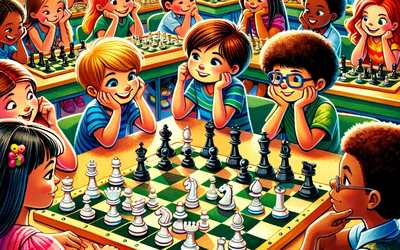
d4 d5 c6 a6 takes takes Be2 g7 takes then b1......What?
The Challenge of Conveying Chess: Bridging the Gap Between Grand Masters and Novice, Family and Kids Chess PlayersYes, the title notation does not make sense, I have just scribbled it!
But this is exactly why I am publishing this article.
I am a 63-year-old male who has loved chess since the age of 13. I currently play at a level of about 1800 on Lichess. While I am expected to know my chess notation and win every game, unfortunately, that is not the case.
As an avid follower of online chess series since Meltwater, I find myself increasingly hooked on chess. However, I have decided to write and publish this article out of pure respect for all the grand masters out there, as well as for the online chess series companies and event organizers who make chess more accessible to all of us.
Introduction:
In the world of chess, effective communication plays a vital role in educating and coaching players of all levels. While grand masters possess exceptional skills and knowledge, they often face challenges when it comes to conveying their expertise to novice players. This article aims to explore the difficulties in chess communication and propose solutions to bridge the gap between grand masters and beginners, all with the intention of enhancing chess education worldwide.
I. The Gap in Chess Communication: Chess notation, particularly the verbal form used by grand masters, can be daunting for novice players to grasp. The intricate and complex language employed to describe moves and game states poses a significant barrier for beginners. As a result, many novice players struggle to keep up with the fast-paced commentary or coaching provided by grand masters, hindering their learning experience.
II. The Art of Conveying Chess Knowledge: Teaching and coaching chess is an art that requires a unique set of skills. Despite their expertise in playing high-level chess, grand masters may not possess the natural talent to effectively convey their strategies and tactics to others. The transition from being a proficient player to becoming a proficient teacher or coach demands patience, clarity, and adaptability.
III. The Case of GM Dawid Howell: One prime example of a grand master who excels in bridging the communication gap is GM Dawid Howell. Howell has showcased his exceptional ability to educate and engage novice players during the Meltwater Online Chess Series. Instead of relying solely on high-level chess notation, Howell adopts a more accessible approach. By utilizing visual aids, colors, and arrows on the computer chess board, he simplifies complex concepts, making them easier for novice players to comprehend and appreciate.
IV. The Impact on Novice Chess Players: Efficient and simplified communication significantly benefits novice players. By employing methods like those used by GM Howell, chess educators and online streaming platforms can enhance the learning experience for aspiring chess players. These initiatives not only provide valuable educational content but also promote an inclusive and a nurturing environment for chess enthusiasts of all levels.
V. The Norway Chess Challenge 2023: While the Norway Chess Challenge offers a platform for grand masters to showcase their skills, there is an opportunity to improve the educational aspect of the event. By emphasizing clarity, simplicity, and patience in conveying chess concepts, commentators can ensure that their commentary is accessible and engaging for all viewers. Integrating communicators like GM David Howell, who excel in catering to novice players, can greatly enhance the educational value of the tournament.
VI. Suggestions for Improving Chess Communication: To enhance chess communication on a broader scale, it is essential to consider various strategies:
- Incorporate visual aids, gestures, and clear explanations alongside chess notation to provide a comprehensive understanding.
- Encourage online chess streaming platforms to prioritize educational goals and strike a balance between entertainment and instruction.
- Embrace diversity in teaching styles and voices within the chess community to cater to the different learning preferences of novice players.
In conclusion, the challenge of conveying chess knowledge to novice players is a significant concern. By acknowledging the difficulties faced by grand masters and advocating for improved communication, we can foster an environment where players of all levels can learn and grow. It is crucial for the chess community, including online chess organizers, to prioritize accessibility and education, and to value the contributions of exceptional communicators like GM David Howell. Through collaborative efforts, we can empower aspiring chess players, irrespective of their current skill level, and pave the way for a more inclusive and effective chess education worldwide.
More blog posts by Homebot

Unlocking Potential: A Chess Class Demo Reveals Early Signs of Talent
Explore the nuances of identifying potential chess talents in children as young as 7, based on real …
Be Nice in the Chat!
Promoting a Positive Chat Environment: A Reflection on Lichess Platform Broadcasting
The Importance of Focus in Chess: Insights from Clifton Strengthsfinder
In part 2 of the Attend to Attention series, Aiden Rayner emphasizes the importance of focus in play…
